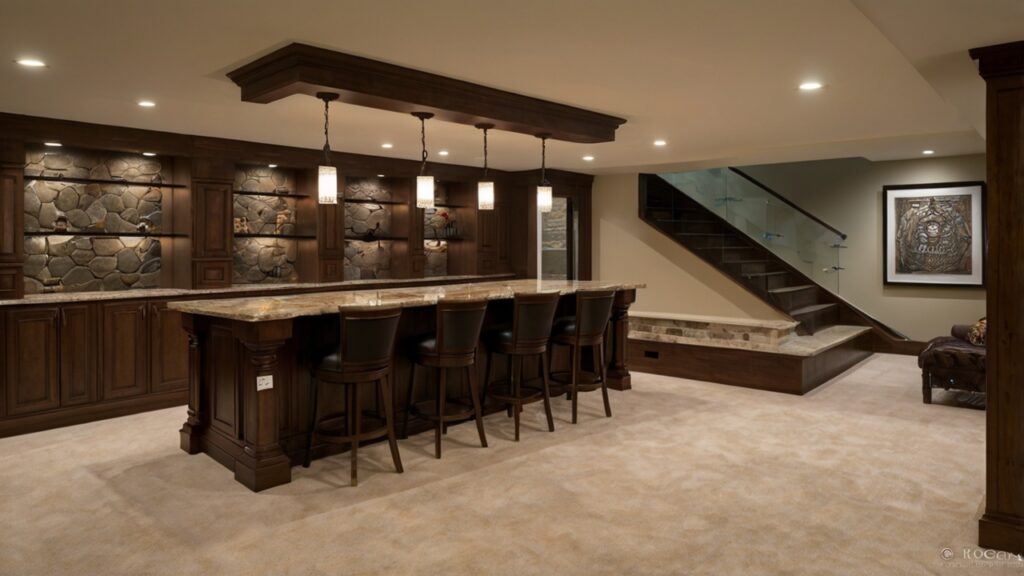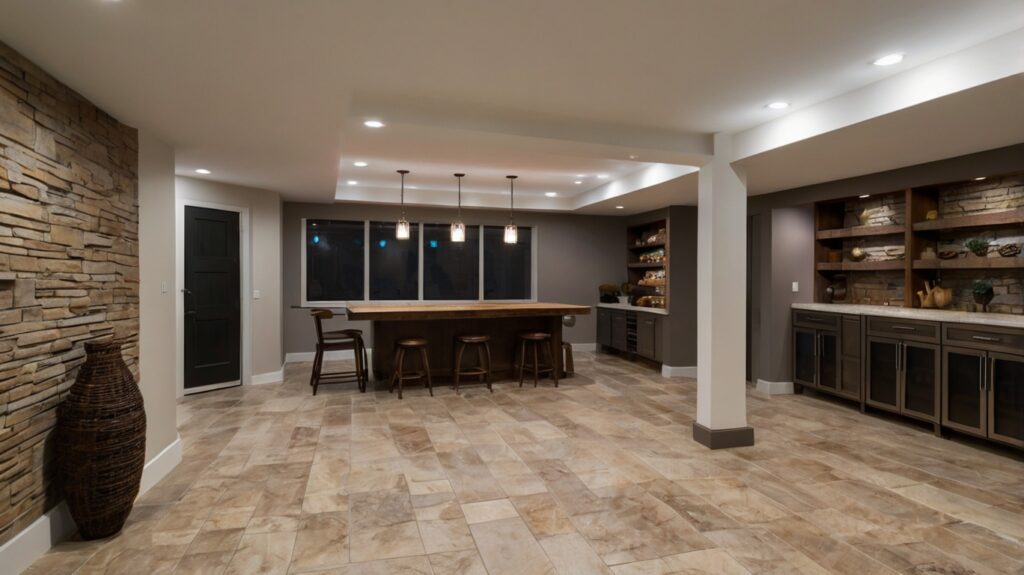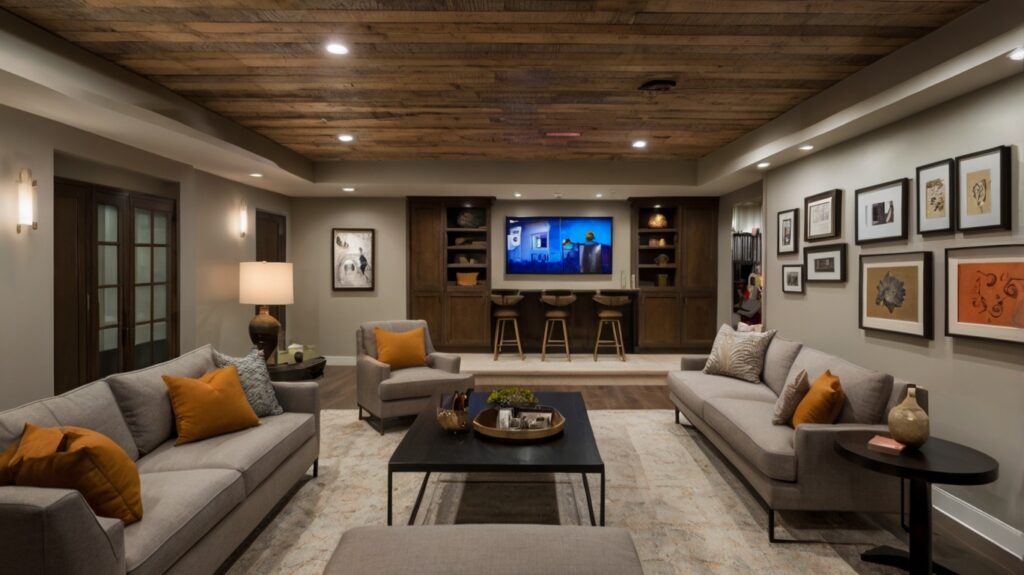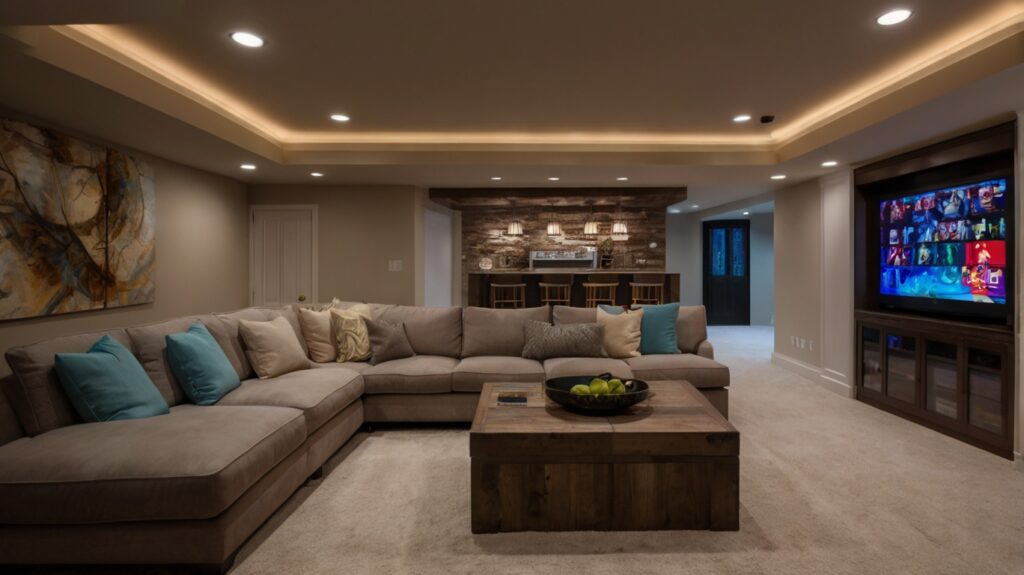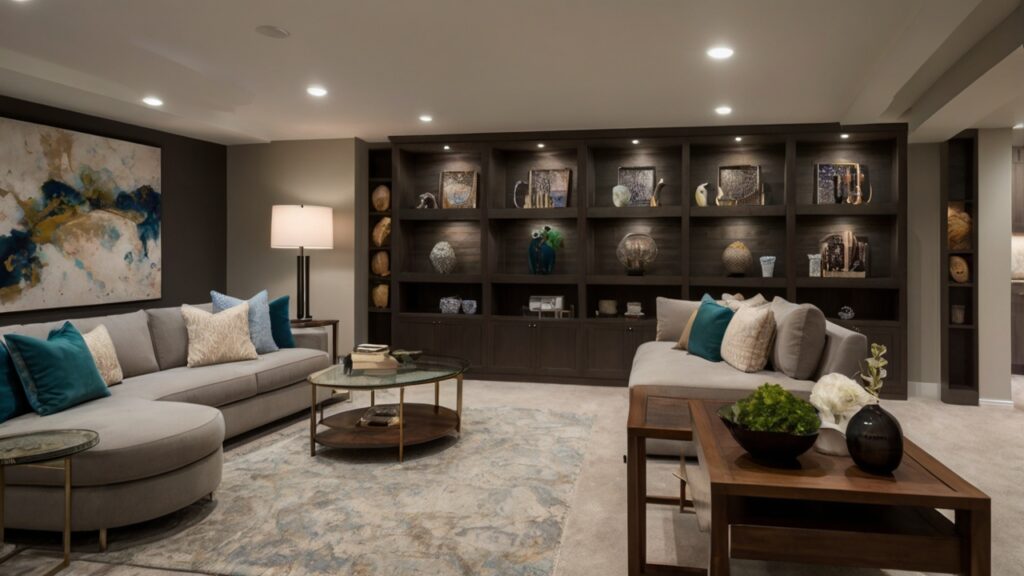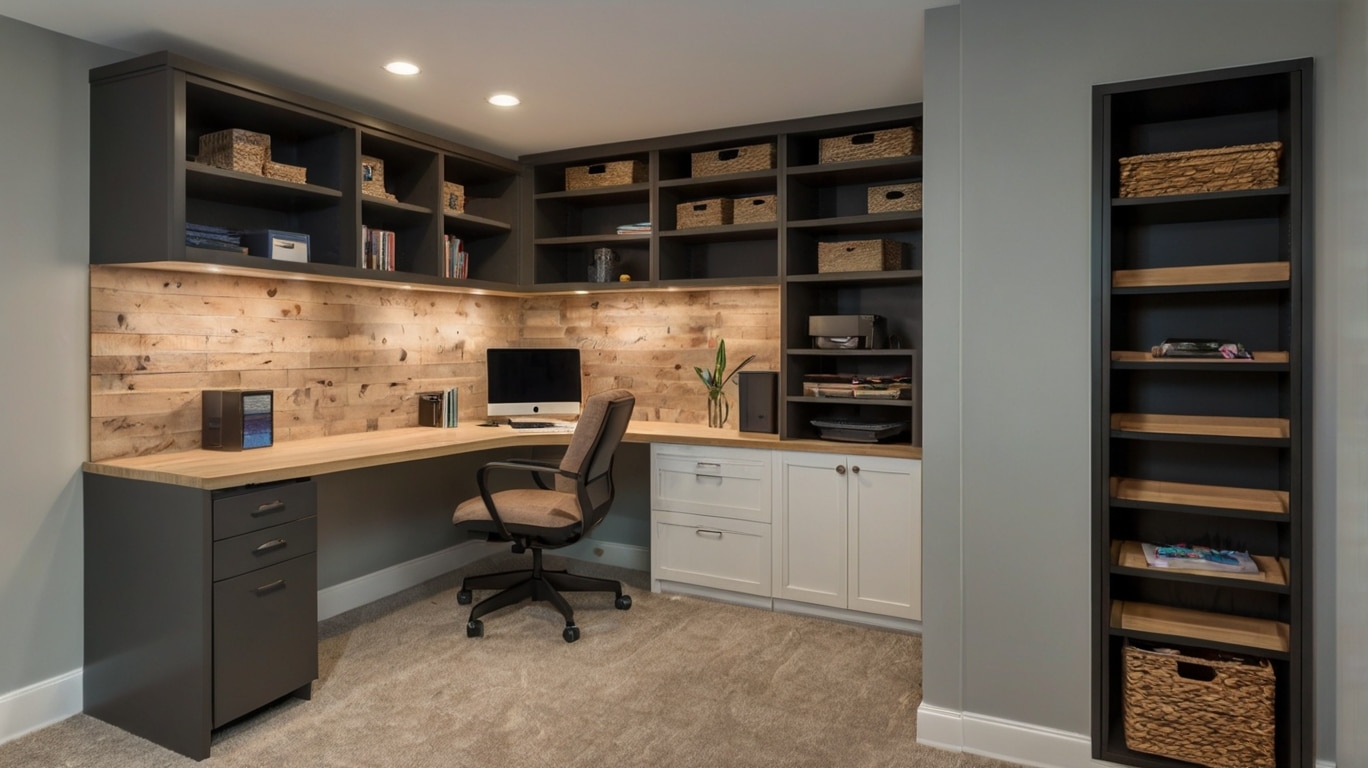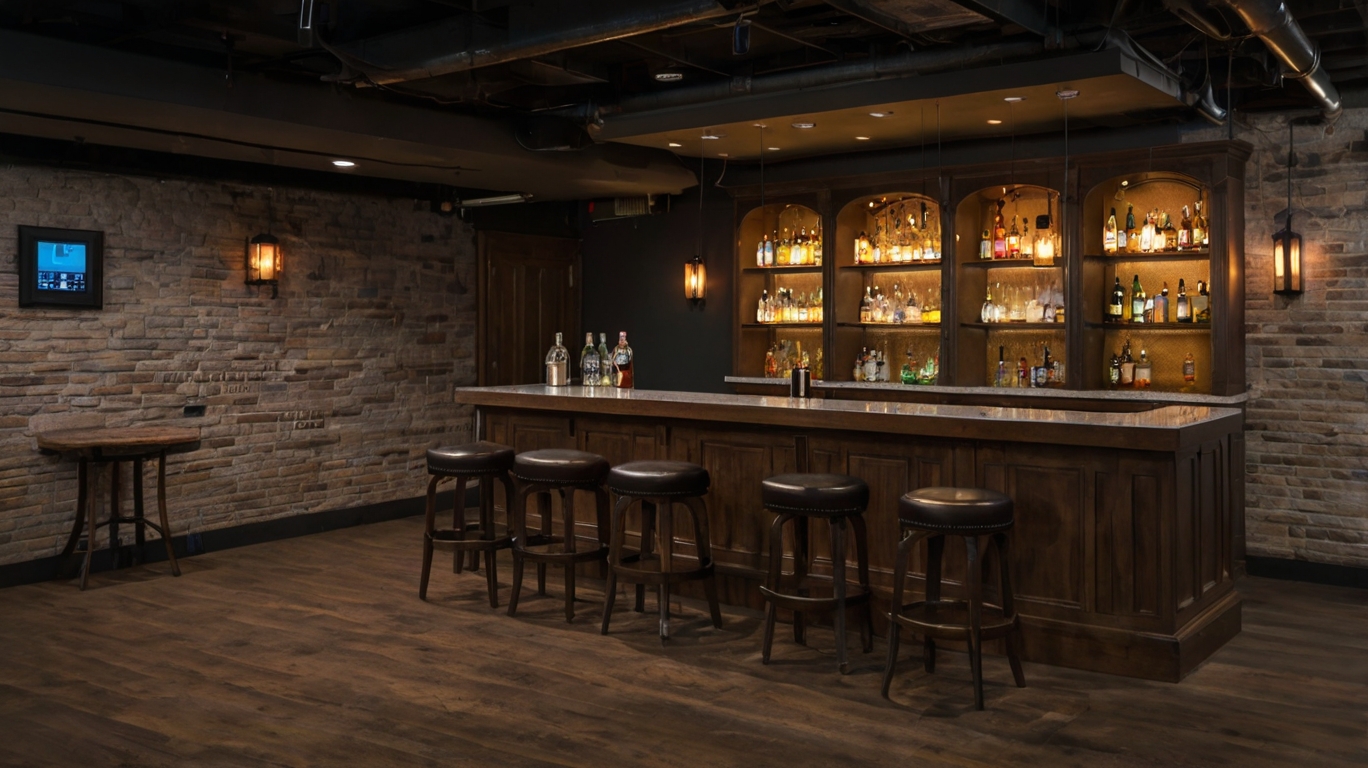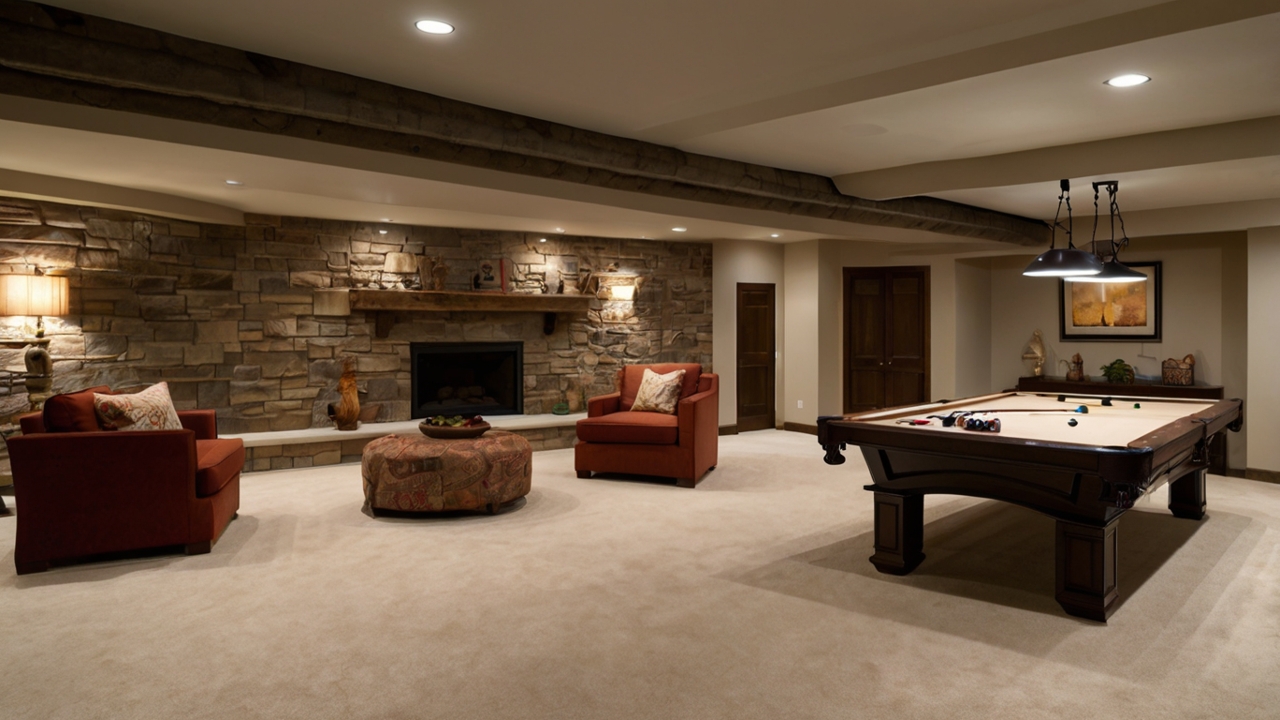
The Ultimate Guide to Choosing the Perfect Basement Finishing Materials20 min read
If you’re reading this, you’re probably contemplating how to transform your basement into a beautiful, functional space. Maybe you’re dreaming of a home theater where you can watch movies with your family, or perhaps you envision a quiet home office, a lively playroom for the kids, or even a personal gym. Whatever your dream for an unfinished basement may be, the journey to achieving it starts with one crucial step: choosing the right finishing materials.
Basements are unique spaces. They come with their own set of challenges like higher humidity, less natural light, and cooler temperatures. These factors make it essential to choose materials that are not only stylish but also practical and durable. The right materials can make the difference between a basement that feels like an afterthought and one that seamlessly integrates with the rest of your home.
Contents
Choosing The Right Basement Finishing Materials
When it comes to finishing your basement, the choice of materials can make or break your project. Unlike other parts of your home, basements have unique environmental conditions that require special consideration. Choosing the right basement finishing materials is crucial for several reasons, primarily related to the unique environmental conditions of basements and the desired functionality and longevity of the finished space.
Additionally, considering the basement ceiling is important for the overall design and functionality, as it impacts headroom, soundproofing, and aesthetics.
Assess Your Basement Renovation Environment
Before diving into materials, it’s essential to understand your basement’s environment. Basements typically have unique conditions like higher humidity levels and a tendency to be cooler and darker. Evaluating these factors will guide your material choices to ensure durability and comfort.
Understanding Moisture Levels
First things first, let’s talk about moisture. Basements are notorious for being damp. Whether it’s due to groundwater seepage, condensation, or the occasional minor flood, moisture is a big player. If your basement has any water issues, those need to be addressed before you even think about finishing.
Waterproofing measures like sealing cracks, installing a sump pump, or adding a dehumidifier can make a world of difference. Once you’ve got that sorted, choosing moisture-resistant materials becomes key. Think vinyl plank flooring or ceramic tiles, which can handle a bit of water without damage.
Temperature and Insulation
Next up, temperature. Basements tend to be cooler than the rest of the house, which can be great in the summer but a bit chilly in the winter. Proper insulation is essential not just for comfort, but also for energy efficiency.
Foam board insulation or spray foam can help keep your basement warm and dry. And don’t forget about the floors! Adding a subfloor can provide a thermal break and make things much cozier underfoot, especially if you’re planning on installing carpet or vinyl planks.
Lighting and Brightness
Let’s not forget lighting. Basements often suffer from a lack of natural light, making them feel dark and gloomy. When planning your basement makeover, consider how you’ll light the space. Recessed lighting is a great option because it doesn’t take up any headroom.
Adding more light fixtures than you think you need can also help combat the lack of windows. When it comes to wall colors, lighter shades can reflect light better and make the space feel more open and inviting.
Structural Considerations
Finally, consider the structural elements. Basements can have low ceilings, exposed beams, and pipes that need to be worked around. Drop ceilings can be a practical solution for hiding ductwork and electrical components while still providing easy access.
Alternatively, embracing an industrial look with exposed ceilings painted in a dark color can save money and add character to the space. Basement remodeling contractors can help manage these structural considerations and avoid potential delays and increased costs by providing realistic project timelines.
Basement Floor Options
Choosing the right flooring for your basement is a critical decision that can significantly impact the look, feel, and functionality of the space. Selecting the right materials for a basement to install flooring in is crucial in the renovation process, with common options like carpet and laminate being popular choices among homeowners.
Basements present unique challenges such as moisture, potential flooding, and cooler temperatures, so it’s essential to pick materials that can handle these conditions while meeting your aesthetic and practical needs.
Vinyl Plank Flooring
Pros: Vinyl plank flooring is a top choice for basements due to its water resistance and durability. It’s designed to mimic the look of natural wood or stone, giving you a high-end appearance without the associated maintenance issues. Vinyl planks are also comfortable underfoot and come with a variety of designs and textures to fit any aesthetic.
Cons: While vinyl plank flooring is resilient, it can be prone to scratches and dents, especially in high-traffic areas. It’s also less environmentally friendly compared to natural materials.
Carpet Tiles
Pros: Carpet tiles offer warmth and comfort, making your basement cozier. They are particularly good for family rooms or play areas. The modular nature of carpet tiles means that if one gets stained or damaged, you can simply replace it rather than the entire floor.
Cons: In flood-prone basements, flooring that traps moisture can be a problem, and carpet tiles are no exception. They also demand extra upkeep to stay clean and odor-free.
Ceramic or Porcelain Tile
Pros: Ceramic and porcelain tiles are excellent for basements due to their water resistance and durability. They come in a variety of colors, styles, and finishes, allowing you to create a sleek and polished look. They are also easy to clean and maintain.
Cons: Tiles can be cold and hard underfoot, which might not be ideal for all types of basements. Additionally, the installation can be labor-intensive and may require professional help.
Engineered Hardwood
Pros: Engineered hardwood offers the beauty of traditional hardwood but with better moisture resistance. It consists of a top layer of real wood veneer over plywood or high-density fiberboard, making it more stable in humid conditions.
Cons: While more moisture-resistant than solid hardwood, it’s still not completely waterproof. It can also be more expensive compared to other basement-friendly options.
Laminate Flooring
Pros: Laminate flooring is an affordable option that offers the appearance of hardwood or tile. It’s easy to install and maintain, and it can handle moderate moisture levels if you choose a water-resistant product.
Cons: Laminate flooring is not entirely waterproof and can be damaged by standing water. It also doesn’t have the same longevity as some other options.
Basement Wall Finishing Materials
When it comes to finishing the walls of your basement, selecting the right materials is essential for both aesthetic appeal and functionality. Basements often face unique conditions such as higher humidity and potential moisture issues, so your choice of wall materials should address these challenges while complementing your overall design vision. Coordinating the entire project of basement finishing, including wall materials, ensures that all aspects are professionally managed for the best results.
Drywall
Pros: Drywall is a popular choice due to its versatility and smooth finish. It’s relatively easy to install and can be painted in any color to match your decor. For basements, it’s best to choose mold-resistant drywall, which is specifically designed to handle higher moisture levels.
Cons: Even mold-resistant drywall can be susceptible to water damage if there are significant moisture issues. It may also require regular maintenance and touch-ups.
Wood Paneling
Pros: Wood paneling can add warmth and a classic look to your basement. It’s durable and can be a good insulator. Opting for moisture-resistant wood or treating it with a protective finish can help it handle basement conditions better.
Cons: Wood can be expensive and may not be ideal if you have significant moisture issues. It can also require more upkeep to prevent warping or cracking.
Paint
Pros: Painting is one of the most cost-effective and versatile ways to finish basement walls. High-quality, mold-resistant paint can help prevent moisture-related problems and is available in a wide range of colors. Light colors can help brighten the space and make it feel larger.
Cons: Paint may need to be reapplied over time, especially if the basement experiences high humidity or if the paint is not specifically formulated for mold resistance.
Stone or Brick Veneer
Pros: Stone or brick veneer can add texture and character to your basement walls, giving them a sophisticated, rustic look. Veneer is generally more resistant to moisture compared to drywall and can make your basement feel more inviting.
Cons: Veneer can be expensive and may require professional installation. It can also make the basement feel a bit heavier and more enclosed if not balanced with lighter decor.
Paneling Systems
Pros: Modern paneling systems, such as those made from insulated foam or composite materials, can offer both insulation and moisture resistance. These panels often come with integrated finishes, reducing the need for additional treatments.
Cons: Paneling systems can be more expensive and may not have the same aesthetic appeal as traditional finishes. Some panels may also require professional installation.
Tiling
Pros: Wall tiles, such as ceramic or porcelain, are highly durable and water-resistant, making them ideal for basement environments. They are also easy to clean and maintain.
Cons: Tiling can be labor-intensive to install and can be cold and hard, which might not be the most comfortable option for all spaces.
Basement Ceiling Choices
The ceiling is an often-overlooked element in basement finishing, but it plays a crucial role in the overall look, feel, and functionality of the space. Your choice of ceiling materials can impact everything from aesthetics to practical considerations like lighting and accessibility. One advantage of using a drop ceiling is that it can effectively conceal pipes and ductwork, providing a cleaner and more organized appearance.
Drop Ceilings
Pros: Drop ceilings, also known as suspended ceilings, are a practical choice for basements. They are installed below the existing ceiling, creating a space for hiding ductwork, plumbing, and electrical systems.
This type of ceiling also offers easy access for maintenance and repairs. Additionally, drop ceilings can be fitted with acoustic tiles to help control noise, which is beneficial for creating a quiet, comfortable environment.
Cons: Drop ceilings can create a lower ceiling height, which may not be ideal if you have a basement with already low ceilings. The tiles can also be prone to staining and may need occasional replacement.
Drywall Ceilings
Pros: Drywall ceilings provide a clean, seamless look and can be painted to match the rest of your basement’s decor. They offer a more polished appearance compared to drop ceilings and can help make a space feel more integrated with the rest of the home. Drywall ceilings can also be used to create interesting architectural features such as recessed lighting or built-in shelves.
Cons: Drywall ceilings can be more challenging to install and require professional help, especially if you need to work around ductwork or other existing plumbing there. They can also make it more difficult to access these systems if maintenance is needed.
Exposed Ceilings
Pros: Exposed ceilings are a popular choice for creating an industrial or contemporary look. This style involves leaving the ceiling beams, pipes, and ductwork visible, often painted in a dark color to add visual interest. Exposed ceilings can add character and height to a basement, making it feel more spacious.
Cons: Exposed ceilings can create a more utilitarian appearance and might not suit all design preferences. They also require regular maintenance to keep pipes and beams looking clean and organized.
Beadboard or Plank Ceilings
Pros: Beadboard or plank ceilings add a touch of traditional charm and can make a basement feel warmer and more inviting. They are available in a variety of materials, including wood and composite, and can be painted or stained to match your decor.
Cons: Wood or composite beadboard can be more susceptible to moisture damage, so it’s important to choose materials treated for basement conditions or install a vapor barrier.
Insulation and Soundproofing
Proper insulation and soundproofing are critical elements in any basement layout and finishing, as they significantly impact comfort, energy efficiency, and noise control. Given the unique environment of basements, including potential moisture issues and their role as multi-functional spaces, choosing the right materials and methods for insulation and soundproofing is essential.
Additionally, a solid concrete floor is crucial for stability and effectiveness when installing systems like sump pumps and framing.
Foam Board Insulation
Foam board insulation is an excellent choice for basements due to its moisture resistance and high thermal insulation properties. It’s often used on walls and floors and can be cut to fit around obstacles like pipes and wiring.
- Pros: High R-value (thermal resistance), moisture-resistant, easy to cut and install.
- Cons: Can be more expensive than other insulation types, and must be installed with care to avoid gaps.
Spray Foam Insulation
Spray foam insulation is a two-component system that, when mixed, expands and hardens into a solid foam. It is a highly effective and versatile option for insulating your home, particularly in areas like basements where moisture and temperature control are critical. This insulation type is known for its excellent thermal resistance, air-sealing capabilities, and ability to address gaps and irregularities.
- Pros: Expands to fill gaps, excellent R-value, air and moisture barrier.
- Cons: Higher cost, requires professional installation due to the complexity of the application.
Soundproofing Materials
Acoustic Panels
Acoustic panels are designed to soak up sound waves and cut down on echoes in a room. You’ll find them in all sorts of shapes, sizes, and materials—like foam, fabric-wrapped fiberglass, or other high-tech stuff.
Soundproof Drywall
Soundproof drywall is built to cut down on noise passing through walls. It’s made by layering sound-dampening materials between regular drywall sheets.
Resilient Channels
Resilient channels are metal strips installed between the drywall and the wall framing. They help decouple the drywall from the framing, reducing sound transmission.
Mass Loaded Vinyl (MLV)
Mass-loaded vinyl is a heavy, flexible material that adds mass to walls, floors, or ceilings, helping to block sound. It’s often used in combination with other soundproofing methods.
Lighting Solutions
Lighting plays a crucial role in transforming a basement from a dark, utilitarian space into a vibrant and inviting area. Effective lighting not only enhances the functionality of the space but also contributes to its overall ambiance and style.
Recessed Lighting
Recessed lighting, also known as can lighting, involves fixtures that are installed into the ceiling, creating a clean and unobtrusive look. These lights are ideal for providing general illumination without taking up visual space. It also provides even, widespread light that can help eliminate shadows.
Track Lighting
Track lighting consists of a mounted track with adjustable fixtures that can be positioned along the track to direct light where needed. This type of lighting is versatile and can be used to highlight specific areas or objects. Also, it is great for accent lighting and highlighting artwork or architectural features.
Pendant Lighting
Pendant lights hang from the ceiling by a rod, chain, or cord and come in various styles and sizes. They are often used to provide focused light over specific areas, such as a bar or seating area. Plus, these lights add a decorative element to the space and can be a focal point.
Floor Lamps
Floor lamps provide both functional and ambient lighting and can be moved and adjusted as needed. They are a flexible option for adding light to different areas of the basement. One benefit this type of lighting offers is its ease of placing and repositioning as needed.
Wall Sconces
Wall sconces are mounted on walls and provide both functional and decorative lighting. They can be used to highlight specific areas or provide ambient light. Plus, these lights provide ambient or task lighting depending on the fixture design and add visual interest and style to the walls.
Finishing Touches
Once you’ve tackled the major elements of your basement renovation, it’s time to focus on the finishing touches that will bring your space together and make it truly feel like home. These final details can enhance the functionality, comfort, and aesthetic appeal of your basement, creating a cohesive and inviting environment.
Furniture and Décor
Tables and Storage
Include coffee tables, side tables, and storage solutions such as bookshelves, cabinets, or media consoles. These pieces help organize the space and provide surfaces for everyday use.
Décor Elements
Area rugs can add warmth, comfort, and visual interest to your basement. They help define different zones within the room and can be used to add color and texture.
Curtains and Blinds
Window treatments help with light control and privacy. Choose fabrics and styles that complement the room’s décor and provide the necessary functionality.
Throw Pillows and Blankets
These add comfort and color to seating areas. They can be easily swapped out to update the look of the space.
Plants and Greenery
Indoor plants add a touch of nature and freshness to the basement. They can improve air quality and bring a lively element to the décor.
Furniture should be chosen based on the primary function of guest room in the basement and the space available. Consider how the space will be used, whether for relaxation, work, or entertainment and select pieces that offer both comfort and utility.
Thoughtful design and décor can transform your basement into a dream basement, creating an ideal space that meets all your needs and desires.
Storage Solutions
Built-In Shelving
Built-in shelving integrates seamlessly with your basement’s walls, offering custom storage solutions that maximize available space. Shelves can be designed to fit specific dimensions and needs.
Cabinets and Closets
Cabinets and closets provide enclosed storage for a variety of items, helping to keep your basement organized and clutter-free. Cabinets and closets can be custom-built or purchased as ready-made units.
Storage Bins and Baskets
Storage bins and baskets are ideal for organizing smaller items and keeping them accessible. They come in various sizes and materials, making them suitable for different types of storage.
Effective storage solutions are essential for keeping your basement organized and functional, especially given its often versatile role as a storage area, entertainment space, or living quarters.
Incorporating smart storage solutions is crucial in creating a functional new living space, ensuring that it remains organized and efficient.
In Conclusion
Finishing a basement is an exciting project that can greatly enhance your home’s functionality and value. With thoughtful planning and the right materials, your basement can evolve from an underutilized area into a cozy family room, a home office, or an entertainment hub, tailored to your needs and lifestyle. A finished basement represents a significant investment, but it offers benefits such as increased living space and home value.
By considering the unique conditions of your basement and selecting materials that address these challenges, you can transform an underutilized space into a valuable and enjoyable part of your home. Happy renovating!
Don’t wait—start your basement remodeling makeover today!
Our expert team is here to help you select the perfect options that fit your style and budget, ensuring a seamless and stunning transformation. Contact us today for a free basement remodeling estimate. Let’s create a basement that’s not just finished, but finished to perfection.





